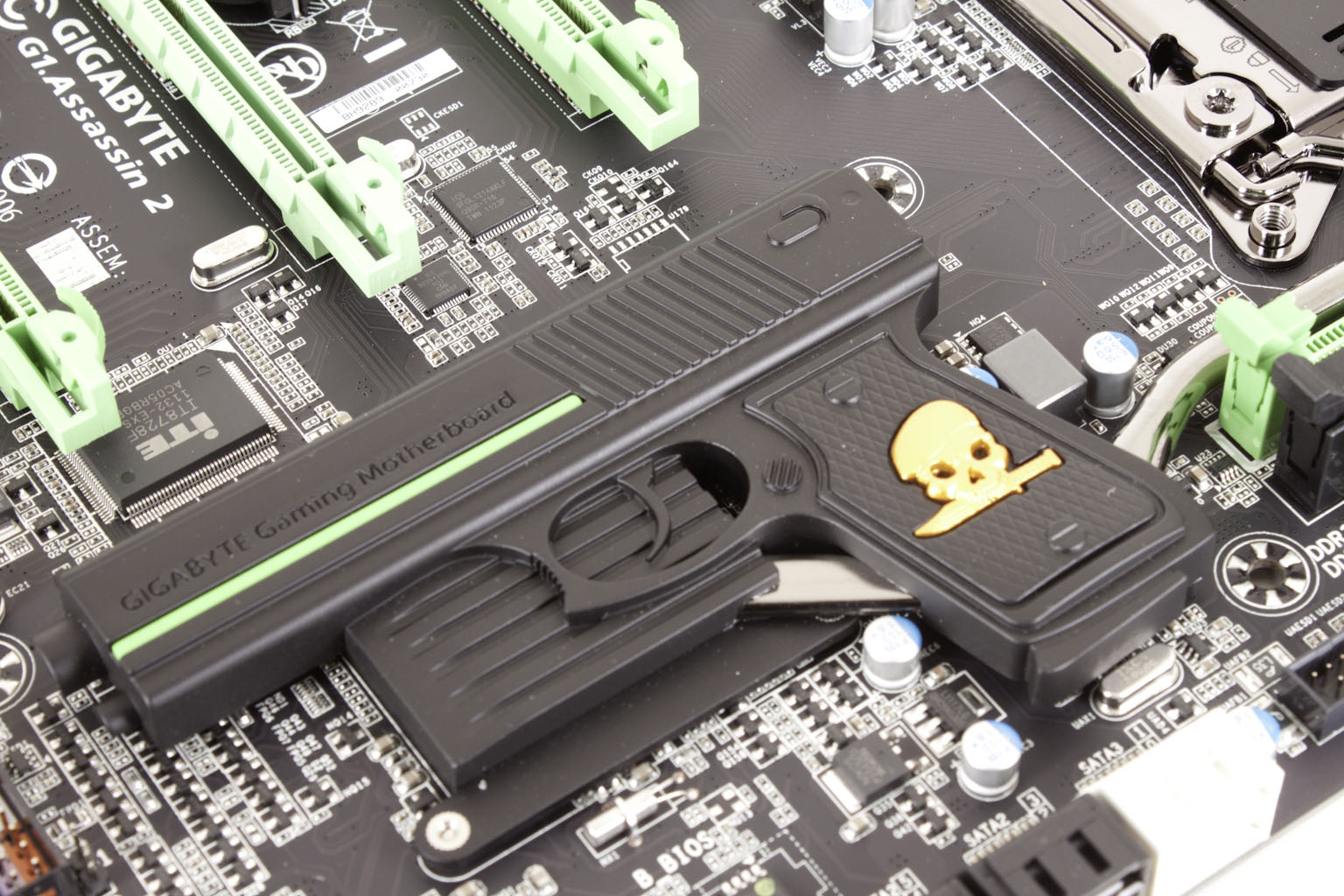The Box and Goodies -
The G1.Assassin2 comes in a box that looks like an Ammo Can. This is the same styling that we saw on the other G1 boards. The front has the now familiar Flaming Skull logo along with some very interesting extras. Right above the logos for the Killer E2100 NPU and the X-Fi 20K2 we find a new logo declaring that the G1.Assassin2 comes with a WiFi Adapter and Bluetooth 4.0 module. Underneath this are the logos for the 3DPower and 3D BIOS (which we will cover later).
 |
 |
The back of the box has more information about the 3DPower and 3D BIOS. It also has a very interesting statement on there. The board says that it is designed for PCIe Generation 3. However, the X79 chipset does not have PCIe Gen 3 lanes in it at all nor do the Sandy Bridge E CPUs. What Gigabyte is talking about here is the Ivy Bridge E CPU. Now these are not due out until late 2012 (Q4 2012) so if you are interested you will have a long time to wait.
Getting back to 3D power we find that it has nothing to do with “3D”, but is actually 3 Ds. These stand for Digital Memory A, Digital CPU and Digital Memory B. We will talk about this in much more detail in the features section and also in our coverage of the G1.Assassin2’s performance. 
One of the things that has made the G1.Assassin series stand out has been the actual built in Audio card on the board. This is not just a CODEC which uses the CPU to processing power; no this is a full audio card with its own audio processor and memory. Along with that you also get very high-quality capacitors and OpAMPs. This time around Gigabyte has also included a front panel headphone amp. This little add-on really is something that many gamers will be very happy about. A headphone amp can dramatically improve the quality and vibrance of your audio even when you do not have high-end headphones.
 |
 |
As typical inside the “box” we just described is another box. This one is also camouflage and contains what you are really here to see. Once we open the flap you get your first glimpse of the G1.Assassin2. Before we talk about the G1.Assassin2, I want to cover some of the other items that you get with this. Gigabyte has really loaded you up this time. You have multiple SLI and Crossfire bridges (including a Three-Way SLI Bridge) good quality SATA cables, a poster, a set of decals and more.
 |
 |
 |
The more consists of a WiFI (802.11n) wireless module that also has Bluetooth 4.0 on it. This module will take up an X1 PCIe slot as well as a standard USB 2.0 header. Interestingly enough the card also has an internal USB port. I am not sure what this is actually intended for, but it might be nice to use for a security dongle if you have an application that requires one. Gigabyte also threw in a USB 3.0 panel. This panel can be mounted in a 3-1/2 inch bay or you can remove the mounting bracket and potentially mount it in the back of a case (if it has the space for it).
So far the G1.Assassin2 is looking pretty good considering everything you get inside the box. Now, let’s take a look at the board design and what it has in store for you.
The Layout -
The layout of any motherboard is important. Even simple mistakes in component placement or the signal traces can cause major issued in performance and stability. With the ATX form factor we find that this is even truer; the devices we drop onto them demand more and cleaner power while the signal speeds push faster and faster. The Gigabyte G1.Assassin2 is a pretty cool looking board. I like the choice of black with green slots and the military themed look. However, the thing that caught my eye the most was the memory slots. For some reason Gigabyte has chosen to only have four on the board. Considering this is a quad-channel product you are loading up your slots with a single kit. There is no room to add more RAM. If you want to increase the amount of RAM you have you will need to replace what you are already using. This is a little disappointing in a board that is intended to be an enthusiast/ gamer’s product.
 |
 |
While I was puzzling over the limited RAM slots I noticed something else. The 8-Pin ATX Aux power connector has been moved. Instead of its usual place between the CPU socket and the I/O ports it is now near the front edge of the board. Unfortunately it is still in an awkward position and difficult to connect when mounted inside a case (get an extension cable here guys). You might also have noticed that the front two slots of RAM are very close to the front edge of the board. This is an odd design choice as there is plenty of space between the CPU/RAM and the I/O ports. We are not entirely sure what Gigabyte was thinking here, but we hope there is some logic behind it.
 |
 |
One reason that Gigabyte might have had is the way they have broken out the power regulation. You can see this evident in the way the components are spaced out. Just in looking at this area of the board we see several digital power control units and along with their accompanying regulators and chokes. Of course the CPU still gets its very own power regulation and a long line of chokes and caps. I do not think a motherboard would be complete without this.
 |
 |
Moving down the board we come to the area reserved for the CreativeLabs X-Fi. If you look closely you can make out the JRC 4556A and the 3 ST C4558 Op AMPs. We imagine the JRC is what controls the front outputs while the 3 ST C4558’s take care of the rest. The Creative CA20K2-2AG Audio Processor and its 128M of Hynix memory stand out quite clearly along the back edge of the board.
 |
 |
Taking a look at the peripheral slots we find three PCIe x16 mechanical slots. However, only PCIe 1 and 3 are x16 electrical. Slot 2 is only x8. This configuration should still lend to some good gaming performance with the right cards. We also can clearly see the Killer E2100 chip and its 1GB of Samsung DDR2. 
Moving on from the interesting items like the Killer E2100 NPU and the Built in Creative X-Fi we come to the more mundane headers for things like USB, TPM (Trusted Platform Module), front panel audio and the panel controls; nothing exciting really. For SATA ports you get a total of eight. Two are controlled by a Marvell SATA 3.0 controller (the grey ones that are set aside) these are part of the G-SATA that Gigabyte likes to put on their boards. The rest are come from the X79 chipset and break down into four SATA 2.0 (the black ports) and two SATA 3.0 (the white ones).
 |
 |
In keeping with the military theme Gigabyte has put a heatsink that is shaped like a pistol over the X79 chipset. This is a cool looking item, I just hope that it is able to actually perform its job and does not end up as a large heater inside of a case. 
The I/O ports on the G1.Assassin2 are not bad, but again I think I was expecting more. There are only two USB 3.0 ports this time and while there are plenty of eSATA and powered USB 2.0 ports I was still hoping for more. Gigabyte did include an overclocking button that allows you to quickly and easily overclock your system. Simply press the button to OC and press it again to return to defaults. The button right under this allows you to switch between the two BIOSes on the G1.Assassin2. This is great if you want to configure each BIOS for a different performance style. You can configure BIOS 1 to have much faster memory and BIOS 2 to push the CPU.
 |
 |
All in all I like the design, but I am still thinking that the lack of memory slots is going to come back and haunt us. Still that is for later; instead let’s move on to talk about the features of the G1.Assassin2.
Features -
In the current market motherboard (and indeed almost all component) performance is very close. The days of a large performance advantage between boards using the same chipset are long gone. That is unless someone makes a HUGE mistake (like runs traces completely wrong). Now, the thing that differentiates different products is the features. These are things like power management, extra slots, better audio CODECs etc. It is these items that R&D teams work so hard to drop into what are really identical pieces of hardware at their most basic level.
The G1.Assassin2 has a ton of features packed into it. Granted not all of them are good enough to get you to buy the board, but there are quite a few that should have you checking this board out very closely.
Excellent -
Bluetooth and Wireless N module
Quad Channel RAM Support (somewhat limited by the number of slots)
Built in Creative X-Fi Audio with Headphone Amp
3D BIOS
3D Power
Killer E2100 NPU
This list all on its own is impressive. The Creative Audio and Headphone amp is one of my personal favorites. The 3D power, should allow for better (or at least more controlled) overclocking. You can also not count out the 3D BIOS which really does make configuring the board interesting. The other items are very nice to see as stock and we are pretty sure they would only add to the boards marketability.
In the middle (sort of good) -
Solid Caps
Dual BIOS
Multiple 4-pin Fan headers
Three-Way SLI (using the CPU)
CrossfireX
These are nice extras but are not items that are going to push things over the edge for a buying decision. With the possible exception of the three-way SLI feature without the need to use a bridge chip.
Floor Mats -
Multiple USB 2.0 headers
USB 3.0
These are the types of things that are filler; again they are nice, but they do not make the board what it is. Like we said you are not getting loaded up with features here, but you are getting a solid and stable board most of the time.
There are also some items that are missing here; we would have liked to have seen onboard power and reset buttons, but for some reason Gigabyte chose to leave them off. Still even without them the G1.Assassin2 has a very nice feature set. We only hope that they can turn these into great performance.
Conclusion –
So far the G1.Assassin2 looks to be a solid board. We are still very concerned about the 4-RAM slot limit, and hope this was not done due to tracing or layout issues on the board. Other than this one concern the rest of the package is very complete with everything thrown in from Wireless, to Bluetooth to a Network Processing Unit in the form of the Killer E2100. This is all rounded out by the Creative X-Fi audio card that is built right on to the board. From a features and design standpoint the G1.Assassin2 is certainly a winner.
Discuss this in our Forum




